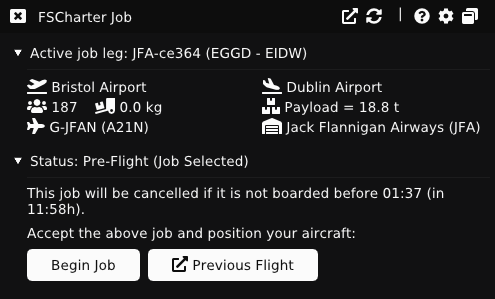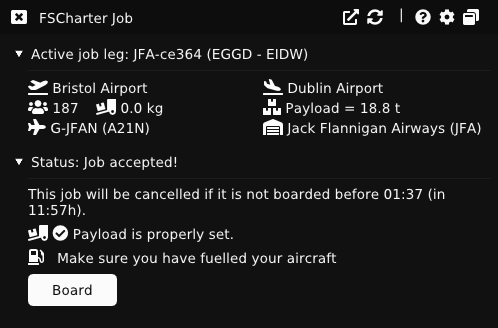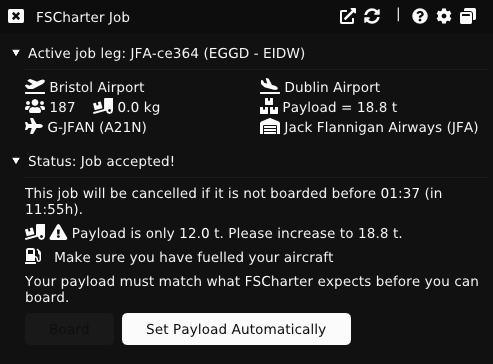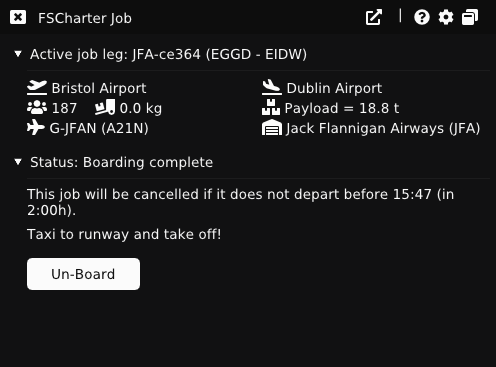Job Flow
Quick Start
The Job window guides you through every stage of a flight - from accepting a job to disembarking at your destination. It displays your current state, expected values, and next required actions.
Accept a job on the FSCharter Marketplace.
In the simulator, open the Job window and click Begin Job to position your aircraft at its last known location.
Click Board to load passengers automatically (or load manually if configured).
Once all messages clear and conditions are met, take off.
Fly within normal parameters (no slewing or time acceleration), land, and disembark.
Beginning a Job
Click Begin Job to position your aircraft at the last known FSCharter location.
If you’ve disabled Location in the plane-specific options, you’ll need to taxi manually to the arrow-marked starting position.

Conditions to Begin
Aircraft parked on the ground
Parking brake on
Engines off
Boarding
Boarding loads the required payload for your active job. By default, the plugin sets these automatically.

Conditions for Boarding
On the ground with parking brake on and engines off
Within approximately 150 m of the last known position
You are responsible for verifying your aircraft’s weight and balance. FSCharter cannot guarantee a safe centre of gravity or enforce per-station load limits. Always verify limits and balance before departure.
Fuel Loading
FSCharter automatically charges the company account for fuel based on how much you add in the simulator. No separate fuel planning is needed on the platform. For longer flights, consider refuelling during stopovers. Fuel is distributed proportionally across tanks.
Payload Loading
The total payload includes cargo, passengers, and the pilot:
Total Payload = Cargo + 100 kg × (Passengers + 1)
X-Plane: Only total payload can be set generically. Redistribute it manually using your aircraft’s tools.
MSFS / P3D: Payload is distributed heuristically across seats, cabins, and cargo areas. The plugin cannot read station maximum limits, so verify balance and CG manually.
See also FAQs: cannot set payload or fuel.
Manual Loading
If Payload is disabled in plane-specific options, you must load payload manually using your aircraft’s loading interface. The Job window will display the expected values; once all messages disappear, loading is within tolerance.

Too little payload at take-off will prevent the flight from starting.
Pre-Flight Checklist
Before taking off, ensure:
Centre of gravity and weight are within safe limits for your aircraft
Payload distribution is sensible and respects per-station limits
Fuel on board covers the trip plus reserves and contingencies
Parking brake is set during boarding (unless your plane options specify otherwise)
Takeoff
Once preparation is complete, verify your aircraft’s balance, start the engines, taxi to the runway, and take off. A popup will confirm successful takeoff when the following are met:
Conditions for Take-off
Near the boarding position
Fuel is at or below the expected value
Payload is at or above the expected value
Aircraft is airborne and exceeding 35 knots or 50 ft AGL

In Flight
During the flight, the Job window displays your current status and expected fuel (calculated as job fuel minus consumption). Click the link icon to open your live flight on the FSCharter platform.
Conditions for Flight
Fuel remains at or below expected levels
Payload remains at or above expected levels
Ground speed stays within type limits (no time acceleration)
No slewing or crashes
Landing
When you land, a popup confirms touchdown, and the Job window will display your landing rate.
Conditions for Landing
On the ground and below 35 knots
Landing rate greater than -750 ft/min
Disembarkation
Taxi to a proper parking position off the runway before disembarking.
Park Properly
FSCharter’s world is persistent - your next flight begins exactly where you leave the aircraft. Be courteous to other pilots and leave the aircraft somewhere sensible.
Automatic vs Manual Disembark
Automatic: Occurs when the aircraft is fully stopped with parking brake set and engines off near the destination airport.
Manual: If Parking Brake or Engines On are enabled in plane-specific options, stop fully and click Disembark manually.
Stopovers
If you need to refuel or divert due to weather, land at another airport to enter Stopover mode.
Park and shut down as you would for disembarking
The Job window will prompt you to configure fuel
Configure your fuel in the simulator
Re-board
Resume the flight as instructed by the plugin
Breaks
You can pause at a stopover for 6 hours (free users) or 12 hours (premium users).